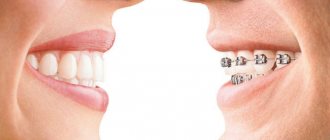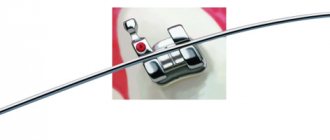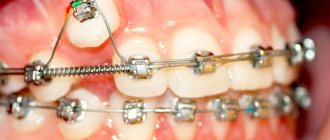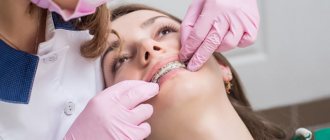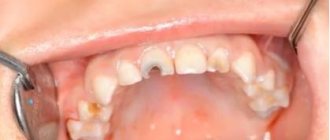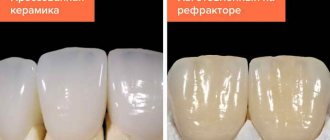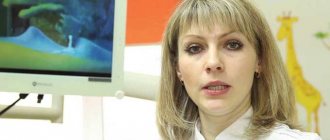People who have decided to get rid of a certain dental defect that reduces their level of comfort in life make an appointment with an orthodontist. Some suffer from a single crooked tooth that disrupts the aesthetics of their smile, while others have already encountered facial deformation caused by several unfolded, incorrectly positioned teeth.
In any case, the future patient is concerned exclusively with the issue of aesthetics, and from treatment with braces he expects only one thing - getting rid of the defect, which is often observed only in the upper or, less commonly, only in the lower jaw. Therefore, the proposal to install a device on both often causes surprise and is regarded as the doctor’s desire to earn extra money by unjustifiably increasing the amount of necessary correction (especially since the cost of turnkey braces is still quite impressive).
To figure out whether it is possible to put braces on one jaw, let's evaluate the situation from the point of view of a specialist.
What are braces?
A brace system is an orthodontic device that is installed on the teeth and helps them move in the desired direction. Structurally, this device consists of small plates (directly braces), which are glued to the dental crown at pre-calculated points, and a metal arch. This arc has shape memory and is an active element of the system. Fixed on the plates, it tries to regain its even position and thereby puts pressure on the teeth. As a result, their slow, gradual movement in the bone tissue occurs. Orthodontic treatment not only helps to correct the curvature of individual teeth in a row, it allows you to change the shape and position of the jaw, and restore facial symmetry.
It is preferable to begin orthodontic correction in childhood. But modern medical capabilities make it possible to carry it out even in adulthood and old age.
Most often, an orthodontic device is placed on two jaws at once. The dentist calculates in advance in which direction a particular tooth should move, how much it is necessary to expand the jaw or spread the dentition. Double-jaw treatment is comprehensive and allows you to solve global problems in occlusion correction. It usually takes from several months to several years.
Can I wear braces during pregnancy?
During pregnancy, women's dental tissue becomes more fragile, and there is a risk of damage to it by orthodontic construction. Can braces be installed during this period? Yes, but ideally it is better to have orthodontic treatment before or after pregnancy. If you already have braces on your teeth, you should definitely inform the orthodontist about the changes in your body. The doctor will prescribe a detailed diagnosis and decide whether braces and pregnancy are compatible.
If everything is in order, treatment with dental braces can be continued as usual. If the effectiveness of orthodontic treatment is questioned, the specialist will recommend removing the system and using retainers until the process can be resumed.
Are braces placed on one jaw?
Installing a brace system is one of the most common and effective methods for correcting an abnormal bite, improper closure of the teeth of the upper and lower jaw. Crooked teeth and abnormal jaw position not only spoil a person’s appearance, but also affect his health. Therefore, correcting the bite is important and necessary. But installing braces confuses many people.
Some are concerned about aesthetics, others are concerned about possible inconveniences when wearing the system, others simply want to save on orthodontic correction. And then the patient turns to the doctor with the following question: is it possible to install braces only on the upper jaw or only on the lower jaw.
As a rule, a person knows in advance which teeth he wants to change. And if they are located only on one jaw, then he expects that he will have a partial braces installed, only in the area of the curvature.
The doctor must make such a decision. It may seem to the patient that he has a problem only with the lower jaw, but the dentist sees during the examination that partial correction will not give an effective result. In this case, the orthodontist will insist on a complete correction. If you need a stable result of orthodontic treatment, we recommend listening to the professional opinion of an orthodontist.
Carrying out diagnostics
Before installing braces, the following diagnostic studies are required:
- orthopantomogram - a panoramic image of the jaw bones, allowing you to see the location of all teeth, their rudiments and roots;
- teleroentgenogram – lateral projection of the skull bones. With its help, the direction of tooth growth is determined for the correct calculation of correction angles;
- photographic recording of teeth and face from different angles;
- casts of the jaws - models are made from them, on the basis of which the design of braces is individually developed;
- articulatory studies.
The “People's Dentistry” clinic is one of the best in St. Petersburg, as it is equipped with the latest equipment for diagnosing and treating dental problems of any complexity. This facilitates the implementation of all diagnostic measures in the shortest possible time.
Main indications for partial correction
In some cases, it is indeed possible to place braces on one jaw, and this approach will be effective. As a rule, these are situations where the teeth are only crooked at the top or bottom, but the bite is not broken and there is no facial asymmetry. Partial correction may be recommended for the following indications:
- one or two teeth are positioned incorrectly;
- slight crowding of teeth (lack of space - up to 3 mm);
- a gap between the front incisors in the absence of pathological closure of premolars and molars;
- correction of the position of teeth before installing dentures;
- the need to avoid sagging of the upper teeth when their antagonists (opposite units) in the lower jaw are absent.
Diagnostics will show how effective braces will be only on the upper jaw or, conversely, on the lower jaw. It should include a visual examination, x-rays, assessment of the condition of bone tissue and dental roots.
Let's consider cases when it is justified to place braces separately on the upper jaw and separately on the lower jaw.
Are braces the last stage of orthodontic treatment?
After removing braces, you need to consolidate the effect of straightening your teeth. For this purpose, retainers are made that will protect teeth from returning to their original place.
There are two types of retainers:
- Removable – transparent, plastic mouth guards. Used only at night or during a certain period.
- Non-removable - made of metal. They are installed on the back surface of the teeth using special composite materials.
The decision on the best method is made by the orthodontist. The aligners must be worn at all times during the first month, removed only for eating and brushing your teeth. On average they are worn for 2 years.
While wearing retention devices, you must visit a doctor every 3-6 months.
Orthodontic correction up to 12 years
Braces are primarily used for children starting in their teens. This is due to the fact that by the age of 11-12 years the formation of the jaws is completed, and the primary bite is replaced by a permanent one. But often, an orthodontist discovers bite problems in a child at an earlier age. Installing partial braces helps solve some of them, as well as prepare teeth for further correction in adolescence.
The doctor can place an orthodontic device on one jaw or individual teeth in order to:
- create space for the eruption of permanent teeth;
- expand one of the jaws;
- close the gap between the front incisors (the so-called diastema);
- correct the incorrect position of one or more teeth that are bothering the child;
- preserve the space left after early removal of baby teeth, which neighboring ones are trying to occupy.
Thus, braces can be placed on one jaw at the age of 9-10 years to solve a specific orthodontic problem. In this case, in adolescence, further, already double-jaw, treatment will be required.
How to brush your teeth with braces?
This is where a traditional toothbrush and toothpaste don't serve their purpose. Therefore, you will need to buy a special orthodontic brush, brushes and floss from the pharmacy. You can also use an oral irrigator if you wish.
This way you can effectively clean your teeth and the area around the locks. Teeth should be thoroughly brushed after each meal, because food debris is deposited on braces, which contributes to the development of caries and does not look aesthetically pleasing. We have repeatedly encountered patients whose teeth are more well-groomed than those of a person without braces.
Braces for the lower jaw only for mild crowding
Crowding is the position of teeth when they are too close to each other. As a result, rotation, curvature, and “layering” of each other occur. If slight crowding is observed only on the lower front incisors, while the upper front incisors are positioned evenly and the lateral ones close correctly, in this case, braces are sometimes placed only on the lower jaw. An important condition for this method is that there must be enough space to move horizontally so that the teeth can take the correct position. This treatment method is chosen in cases where the lack of space for alignment is less than 3 mm. With this method, separation of the front incisors is almost always performed - that is, minor grinding of the contact surfaces, which allows you to free 0.25 mm from each surface and in total create those missing 1-3 mm for alignment in the dentition.
Does teeth straightening hurt?
The installation of braces itself is painless, but requires patience because it takes about an hour.
For 7-10 days, teeth may hurt when biting. The body must get used to foreign objects. In general, you live your old life, you just notice pleasant changes in yourself.
Control visits are needed to correct the process and form the correct position of the teeth. Usually after changing the arch the pain goes away within 3-7 days. It all depends on individual sensitivity.
For some, wearing braces is only unpleasant, for others, on the contrary, it is painful, and some do not feel anything.
Treatment for crowded upper anterior incisors
Braces on the upper jaw only can be placed if crowding is observed on the upper front incisors. The conditions are the same - the space deficit should be no more than 2-3 mm. In addition, treatment should not require expansion of the dentition. In this case, for orthodontic correction it is not necessary to involve the lower dentition.
If you provide space for uneven teeth by expanding the upper row, this will disrupt the closure. As a result, the teeth will “seek contact” with each other, the upper row will become narrow again, and in the long term the goal of orthodontic treatment will not be achieved. Therefore, if it is necessary to expand the upper row of teeth in order to correct crowding, a partial braces system cannot be used; a two-jaw apparatus will have to be installed. Braces can only be placed on the upper jaw if space for teeth is freed up using the separation method (their width is reduced by grinding the contact surfaces).
Do's and don'ts when straightening teeth with braces
Orthodontic treatment is a long and responsible process. At home, braces require compliance with a number of rules.
- Hard and sticky foods should be excluded from your diet to avoid damaging your dental braces or getting food stuck in them.
- Sudden changes in temperature in the oral cavity should not be allowed (that is, ice cream should not be washed down with hot tea). This affects the elasticity of the orthodontic arch and can lead to the clasp coming off.
- To prevent ceramic or plastic braces on your teeth from staining, you should avoid coffee, jam, wine and drinks with dyes. Smoking also causes the system to change color.
- The oral hygiene procedure should be carried out using an irrigator, floss (dental floss) and a special brush with V-shaped bristles. Oral care is necessary after every meal.
- If the braces are loose or come off, there is no need to worry - just consult a doctor, and he will easily and quickly correct the situation.
At first, after you start correcting your teeth with braces, all these restrictions may seem quite burdensome and make you think: was it worth getting braces? However, the patient gets used to them very quickly. In addition, the result of the treatment definitely justifies all these not so pleasant nuances.
Important!
Is it possible to do an MRI with braces? If a patient with an orthodontic device is undergoing an MRI of the brain or jaw, the doctor should be informed about the presence of the system. Metal braces can distort diagnostic results. However, undergoing an MRI in braces does not pose any danger to the body.
Closing the gap between the front incisors
Braces can be placed on the lower jaw if there is a large gap (diastema) between the lower front incisors. In this case, several conditions must be met:
- the lateral teeth close together normally;
- there is an opportunity for a “joint to joint” closure of the front teeth of the upper and lower rows.
If these conditions are not met, it may be necessary to artificially increase the size of those teeth between which there is a gap. This is done using filling material. If the patient is not ready to fill healthy teeth in order to increase their size, then single-jaw treatment of diastema will not suit him, since the doctor will not be able to guarantee the stability of the result.
Do braces make it difficult to eat?
Once installed, you will need to learn how to eat in them. This period takes on average 3-7 days.
At this time, give preference to soft and liquid foods. Cut fruits and vegetables into small pieces. Avoid fibrous and sticky foods.
Over time, you will be able to eat almost everything except Coca-Cola (can dissolve glue), hard foods (nuts, crackers, chocolate) and sticky sweets (chocolate, cookies or caramel bars). You should also not chew gum.
Partial bracket system for preparation for prosthetics
Sometimes braces are placed on only one jaw in preparation for prosthetics or in order to close empty spaces from extracted teeth. In the first case, braces help change the angle of the teeth to make room for an implant or bridge. In the second case, the brace system is used to move the posterior chewing tooth to the place of the previously removed one, thereby closing the empty gap and avoiding prosthetics. It is important to note that such treatment is usually complex and lengthy (tooth movement can take up to four years).
The orthodontist decides how appropriate it is to install a partial brace system for such indications in each specific case.
How do braces differ from each other?
| Type of braces | Materials | Differences | Price |
| Metal | metal alloy | reliable and cheap | from 50,000 rubles* |
| Ceramic | ceramics | the most inexpensive of aesthetic | from 70,000 rubles* |
| Sapphire | artificial sapphire | beautiful and relatively inexpensive | from 100,000 rubles* |
| Lingual | gold + metal | completely invisible | From 150,000 rubles* |
*Prices are indicative in Moscow and only for the bracket system.
Should I install braces on one jaw or not?
If the patient is concerned about the question of whether braces are placed on the lower jaw, then the answer will be positive. An orthodontic device can be installed not only on the lower or upper jaw, but also on individual teeth or areas of the dentition. But the main question is whether such treatment would be advisable. As a rule, installing a brace system on one jaw solves exclusively local dental problems. This process is more difficult to control and provides fewer treatment options. If contraindications are not provided, even a successful result will be short-lived, and the teeth will return to their previous position.
Thus, a dentist planning single-jaw orthodontic treatment must carefully assess the risks, take into account the many factors that will influence tooth movement and predict in advance the effectiveness and stability of the result.
If the doctor sees that solving the problem with a partial braces system will be problematic, he will recommend double-jaw treatment to the patient. Its advantages are that teeth can move in different planes without negative effects such as disruption of contacts between the upper and lower ones. Plus, such treatment is easier to predict and control, and it gives a more sustainable result.
MATERIAL FOR MANUFACTURING ORTHODONTIC SYSTEMS
The choice of material for orthodontic structures is quite wide:
- metal;
- plastic;
- ceramics;
- dental sapphire.
Metal ones are the cheapest. Metal braces look scary, but they are one of the best in terms of treatment effectiveness. The metal does not stain when worn, does not bend or break.
Patients try to choose inconspicuous structures made of plastic/ceramics/sapphire for the upper jaw. However, everything has its own characteristics. For example, plastic braces begin to turn yellow over time and may not withstand the load - they break. Such designs can be worn for no more than six months with a slight curvature of the row.
Ceramics are more resistant to stress compared to plastic. Ceramic braces can be almost invisible if the color of the material is matched to the tone of the enamel. Sapphire braces are made from a special crystal grown under certain conditions. Such hardware structures are not inferior in strength to metal ones and are not noticeable. The whole issue is the high price.
Installation steps
- Taking impressions. Casting plaster models. Drawing up a treatment plan (calculating the directions in which each tooth will be moved using braces).
- Coordination of the developed treatment plan with the patient. Approval and signing of the estimate determining the price for treatment with braces.
- Prepayment from the patient.
- Purchase of a set of equipment - the braces themselves and all the necessary components for them (ligatures, mini-implants, etc.).
- Cleaning of teeth and mouth (included in the total cost of treatment).
- Fixation - first on the upper jaw, and after some time (taking into account the clinical case) on the lower jaw.
- The patient visits the doctor in accordance with the treatment plan (usually braces need to be adjusted 1-2 times a month).
- After achieving the desired result of treatment with braces, retention is performed - consolidation of the results, for which retainers (or retention devices) are used, which are selected by the doctor.
- Removal, cleaning of the oral cavity, issuing recommendations and scheduling preventive examinations.
Popular myths
1. It's not nice. There is a myth that fixed appliances do not look very aesthetically pleasing, and the person wearing them cannot look attractive. But modern braces do not affect the aesthetics of a smile. Firstly, there are lingual braces that are completely invisible to others. Secondly, even external braces can be beautiful: sapphire, ceramic, and plastic structures can even add a certain charm to your smile.
2. Braces are only for children. Many patients still have associations with braces - teenage schoolchildren. But it has no basis. Children and adolescents have more options and correction methods, and removable orthodontic appliances are more often used. Adults with a mature dental system have fewer options - braces are used more often as a powerful tool. It is worth noting that there are no upper age restrictions for braces - they are successfully used at both 25 and 60 years old. The older the patient, the longer the retention period, that is, the result will have to be consolidated longer, and this is the only age difference;
3. It hurts. This myth has a reasonable explanation; indeed, pain and discomfort do occur, but not all the time. It may be painful the first few days after installation. This is a normal symptom that occurs as a result of pressure on the teeth. Most patients report moderate pain and itching in the gums, which go away on their own and do not require correction with medications. But everyone has their own pain threshold and perception of pain, so the doctor will tell you how to get rid of unpleasant sensations.
4. It's harmful. It is believed that the non-removable structure destroys the teeth. But preliminary diagnosis is needed in order to assess the strength of the enamel and the risks of complications. Normal enamel can withstand the structure, and compliance with hygiene and doctor’s recommendations eliminates the risk of developing caries in areas of the teeth near braces.
